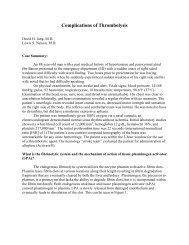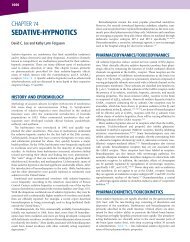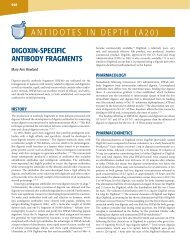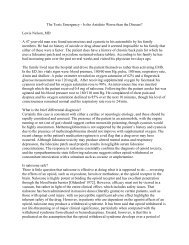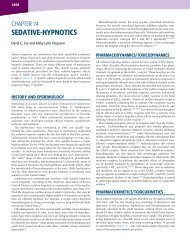Chapter 98 Selenium - Goldfrank's Toxicologic Emergencies
Chapter 98 Selenium - Goldfrank's Toxicologic Emergencies
Chapter 98 Selenium - Goldfrank's Toxicologic Emergencies
You also want an ePaper? Increase the reach of your titles
YUMPU automatically turns print PDFs into web optimized ePapers that Google loves.
1316<br />
CHAPTER <strong>98</strong><br />
SELENIUM<br />
Diane P. Calello<br />
<strong>Selenium</strong> (Se)<br />
Atomic number<br />
Atomic weight<br />
Normal concentrations<br />
Whole blood<br />
Serum<br />
Urine<br />
Hair<br />
= 34<br />
= 78.96 daltons<br />
= 0.1–0.34 mg/L (1.27–4.32 μmol/L)<br />
= 0.04–0.6 mg/L (0.51–7.6 μmol/L)<br />
< 0.03 mg/L (
TABLE <strong>98</strong>–1. <strong>Selenium</strong> Compounds<br />
Chemical Oxidation<br />
Name Formula State<br />
Uses<br />
<strong>Selenium</strong> Se 0 Photography, catalyst,<br />
(elemental) dietary supplement,<br />
xerography<br />
<strong>Selenium</strong> sulfide SeS 2 2 − Antidandruff shampoo,<br />
fungicide<br />
Hydrogen selenide H Se 2 2− —<br />
Dimethylselenide CH SeCH 3 3 2 − Metabolite, garlic odor<br />
<strong>Selenium</strong> dioxide SeO 2 4 + Catalyst, photography,<br />
glass decolorizer,<br />
vulcanization of rubber,<br />
xerography<br />
<strong>Selenium</strong> SeOCl 2 4 +<br />
oxychloride<br />
Solvent, plasticizer<br />
Selenious acid H SeO 2 3 4 + Gun bluing solution<br />
Sodium selenite Na SeO 2 3 4 + Glass and porcelain<br />
manufacture<br />
<strong>Selenium</strong> SeF 6 6 + hexafluoride<br />
Gaseous electrical insulator<br />
Sodium selenate Na SeO 2 4 6 + Glass manufacture,<br />
insecticide<br />
TABLE <strong>98</strong>–2. <strong>Selenium</strong> Regulations and Advisories<br />
Oral—Recommended Intake and Exposure Limits<br />
RDA (2000)<br />
55 μg/d a<br />
NAS-TUL<br />
400 μg/d<br />
ATSDR-chronic oral MRL b Water—Limits<br />
5 μg/kg/d<br />
WHO<br />
Drinking water 0.01 mg/L<br />
FDA<br />
Bottled water 0.05 mg/L<br />
EPA<br />
MCL, drinking 0.05 mg/L<br />
Air—Limits c<br />
NIOSH<br />
REL (TWA)<br />
IDLH<br />
OSHA<br />
PEL (TWA)<br />
0.2 mg/m 3<br />
1.0 mg/m 3<br />
0.2 mg/m 3<br />
(0.8 μg/kg/d)<br />
(5.7 μg/kg/d)<br />
a Values differ for pregnant and lactating women, children, and neonates.<br />
b No acute or intermediate MRL has been established. Chronic ≥ 365 days.<br />
c Ambient background air concentrations are usually in the ng/m 3 range.<br />
AHTSDR, American Toxic Surveillance and Disease Registry; EPA, Environmental Protection<br />
Agency; FDA, Food and Drug Administration; IDLH, Immediately Dangerous to Life<br />
or Health; MCL, maximum contaminant level; MRL, minimal risk level; NAS, National<br />
Academy of Sciences; NIOSH, National Institute for Occupational Safety and Health; OSHA,<br />
Occupational Safety and Health Administration; PEL, permissible exposure limit; RDA,<br />
recommended daily allowance; REL, recommended exposure limit; TUL, tolerable upper<br />
limit; TWA, time-weighted average; WHO, World Health Organization.<br />
<strong>Chapter</strong> <strong>98</strong> <strong>Selenium</strong><br />
1317<br />
peroxidase catalyses the reduction of hydrogen peroxide to water and<br />
oxidized glutathione (GSSG, or glutathione disulfide); the reaction occurs<br />
3, 32<br />
by concomitant oxidation of the selenocysteine unit on the enzyme.<br />
Other selenocysteine-containing proteins, such as thioredoxin reductase,<br />
also appear to have antioxidant properties. The selenocysteine-containing<br />
thyroid hormone deiodinases are responsible for the conversion of<br />
thyroxine (T ) to the active triiodothyronine (T ) form.<br />
4 3<br />
In selenium deficiency, glutathione peroxidase activity is decreased,<br />
and GSH and glutathione-S transferases are increased. 32 Consequently,<br />
selenium-deficient rats are more resistant to substances detoxified by<br />
glutathione-S transferase, such as acetaminophen and aflatoxin B 5 , and<br />
less resistant to other prooxidants, such as nitrofurantoin, diquat, and<br />
paraquat. 5 In animal studies of metal toxicity, selenium also appears to<br />
modify the effects of silver, cadmium, arsenic, copper, zinc, mercury,<br />
and fluoride; conversely, vanadium, tellurium, and arsenic modify the<br />
effects of selenium deficiency or excess. 13, 16, 18, 28, 36 Although it is proposed<br />
that this is accomplished through the formation of insoluble selenium–<br />
metal complexes, these relationships are not entirely understood. 11<br />
Less is known about the biochemical mechanism of selenium toxicity,<br />
and what is known is from in vitro data. Paradoxically, excess selenium<br />
causes oxidative stress, presumably as a result of prooxidant selenide<br />
(R-Se − ) anions. In addition, the replacement of selenium for sulfur in<br />
enzymes of cellular respiration may cause mitochondrial disruption,<br />
and the substitution of selenomethionine in place of methionine may<br />
interfere with protein synthesis. Integumentary effects are also most<br />
likely a result of selenium interpolation into disulfide bridges of structural<br />
proteins such as keratin. 40<br />
PHARMACOKINETICS AND TOXICOKINETICS<br />
Gastrointestinal (GI) absorption varies with the species of selenium,<br />
and human data are limited. Elemental selenium is the least bioavailable<br />
(≤50%), followed by inorganic selenite and selenate salts (75%) 23 ;<br />
selenious acid is quite well absorbed in the lungs and GI tract (∼85% in<br />
animal studies 8 ). Organic selenium compounds are the best absorbed<br />
at approximately 90% as determined by isotope tracers in human<br />
2, studies. 21<br />
Inhalational absorption was documented in a group of workers<br />
2, 15<br />
exposed to selenium dioxide and hydrogen selenide gas, but quantitative<br />
inhalation studies in humans are not available. Dermal absorption<br />
appears to be limited. <strong>Selenium</strong> disulfide shampoos are not systemically<br />
absorbed as measured by urinary selenium levels 8 except in cases of<br />
repeated use on excoriated skin. 31<br />
The toxic dose of selenium varies widely between selenium compounds,<br />
as demonstrated by LD (median lethal dose for 50% of test<br />
50<br />
subjects) animal studies, 36 making milligram per kilogram exposure<br />
estimates difficult to interpret. Elemental selenium has no reported<br />
adverse effects in acute overdose, although long-term exposure may<br />
be harmful. The selenium salts, particularly selenite, are more acutely<br />
toxic, as is selenium oxide (SeO ) through its conversion to selenious<br />
2<br />
acid in the presence of water. Selenious acid may be lethal with as little<br />
as a tablespoon of 4% solution in children.<br />
Metabolic conversion of all forms of selenium to the selenide anion<br />
occurs through various means ( Fig. <strong>98</strong>–1 ), and the selenide ion undergoes<br />
one of three fates: (1) incorporation into selenoproteins such as<br />
glutathione peroxidase and triiodothyronine; (2) binding by nonspecific<br />
plasma proteins such as albumin or globulins; or (3) hepatic methylation<br />
into nontoxic, excretable metabolites. Trimethylselenide is the primary<br />
metabolite and is excreted by the kidneys, the major elimination pathway<br />
for selenium. Fecal elimination also occurs. Dimethylselenide production<br />
is usually minor but increases with exposure; this compound is<br />
volatilized through exhalation and sweat and is responsible for the garlic
1318 Part C The Clinical Basis of Medical Toxicology<br />
Exhaled<br />
odor of patients exposed to excess selenium. The remaining selenium<br />
1, 36<br />
in the body is greater than 95% protein bound within 24 hours.<br />
Toxicokinetic data are limited and vary by compound, and the significance<br />
of metabolism in acute selenium salt poisoning is unclear.<br />
CLINICAL MANIFESTATIONS<br />
■ ACUTE<br />
Se-cysteine<br />
Methylation Selenide<br />
(CH3) 2Se<br />
(CH 3) 3Se<br />
Urine<br />
Se-methionine<br />
Se°<br />
<strong>Selenium</strong>-binding<br />
proteins<br />
Se-cysteine b-lyase<br />
Selenite<br />
Selenate<br />
Selenoproteins<br />
(glutathione peroxidase,<br />
selenoprotein P)<br />
FIGURE <strong>98</strong>–1. Metabolism of selenium. The selenide anion is central in selenium<br />
metabolism. Organic selenocysteine is converted via the β-lyase enzyme to elemental<br />
selenium and then to selenide. Selenomethionine may either undergo transsulfuration<br />
to selenocysteine or methylation to excretable metabolites. The selenate and<br />
selenite salts are reduced to selenide. Selenide then undergoes one of three processes:<br />
methylation, incorporation into selenoproteins, or binding by nonspecific plasma<br />
1, proteins. 13<br />
Dermal and Ophthalmic Exposure Dermal exposure to selenious acid<br />
or to selenium dioxide (which is converted to selenious acid) and to<br />
selenium oxychloride (a vesicant that is hydrolyzed to hydrochloric<br />
acid) causes significantly painful caustic burns. 10 Excruciating pain may<br />
result from accumulation under fingernails. Corneal injury with severe<br />
pain, lacrimation, and conjunctival edema is reported after exposure<br />
to selenium dioxide sprayed unintentionally into the face. 24 In chronic<br />
exposures, “rose eye,” a red discoloration of eyelids with palpebral<br />
conjunctivitis, is also described.<br />
Inhalational Exposure When inhaled, all selenium compounds have the<br />
potential to be respiratory irritants. In general, inhaled elemental selenium<br />
dusts are less injurious than compounds converted to selenious<br />
acid. Hydrogen selenide inhalation toxicity is reported throughout<br />
the industrial literature. 6 Hydrogen selenide is oxidized to elemental<br />
selenium, so acutely, toxic exposures are limited to confined spaces<br />
where the hazardous gas may accumulate; however, similar to hydrogen<br />
sulfide (H S), its ability to cause olfactory fatigue, rendering the<br />
2<br />
exposed persons anosmic to the toxic fumes, may prove very hazardous<br />
(see Chap. 20). 6 Acute exposure to high concentrations of hydrogen<br />
selenide gas produces throat and eye pain, rhinorrhea, wheezing, and<br />
pneumomediastinum, with residual restrictive and obstructive disease<br />
that may persist years later. 33<br />
In contrast, selenium dioxide and selenium oxide fumes form<br />
selenious acid in the presence of water in the respiratory tract. Twentyeight<br />
workers in a selenium rectifier plant were inadvertently exposed<br />
to smoke and high concentrations of selenium oxide in an enclosed<br />
area. Initial symptoms included bronchospasm with upper respiratory<br />
irritation and burning. Some acutely developed hypotension, tachycardia,<br />
and tachypnea, which resolved over 2 hours. Patients went on to<br />
develop chemical pneumonitis, fever, chills, headache, vomiting, and<br />
diarrhea. Five patients required hospitalization for respiratory support,<br />
with fever, leukocytosis, and bilateral infiltrates. All patients recovered<br />
without sequelae. 44<br />
<strong>Selenium</strong> hexafluoride is a caustic gas used in industrial settings<br />
as an electrical insulator. Its caustic properties are derived from its<br />
conversion, in the presence of water, to elemental selenium and hydrofluoric<br />
acid. Severe pain and burning of the eyes, skin, and respiratory<br />
tract similar to that seen with hydrofluoric acid exposure can occur<br />
after inhalation of selenium hexafluoride (see Chap. 105).<br />
Oral Exposure Acute selenium toxicity occurs after ingestion of inorganic<br />
selenium compounds, which include sodium selenite, sodium<br />
selenate, selenium dioxide, hydrogen selenide, selenic acid, and selenious<br />
acid. Selenious acid is the most toxic of these. Elemental selenium<br />
and organic selenium compounds do not cause acute toxicity.<br />
Some authors have proposed a “triphasic” course of acute inorganic<br />
selenium toxicity, with GI, myopathic, and circulatory symptoms as the<br />
overdose progresses. 39 In reality, acute inorganic selenium poisoning<br />
is often rapid and fulminant, with onset of symptoms within minutes<br />
and, in some cases, death within 1 hour of ingestion. GI symptoms<br />
are the most commonly described and the first to occur and include<br />
abdominal pain, diarrhea, nausea, and vomiting. This may be partly<br />
caused by caustic esophageal and gastric burns but does not occur<br />
in all cases. Patients may have a garlic odor. The myopathic phase is<br />
characterized by weakness, hyporeflexia, myoclonus, fasciculations,<br />
and elevated creatine phosphokinase (CPK) concentrations with normal<br />
MB fraction. Renal insufficiency is also reported and presumably<br />
results from myoglobinuria and hemolysis. More severely poisoned<br />
patients may exhibit lethargy, delirium, and coma.<br />
Circulatory failure is the hallmark of serious inorganic selenium<br />
toxicity. Patients present with dyspnea, chest pain, tachycardia, and<br />
hypotension. The initial electrocardiogram (ECG) may demonstrate ST<br />
elevation, a prolonged QT interval, and T-wave inversions. Refractory<br />
hypotension occurs as a combined product of decreased contractility<br />
from toxic cardiomyopathy and decreased peripheral vascular resistance.<br />
Pulmonary edema, ventricular dysrhythmias, myocardial and<br />
mesenteric infarction, and metabolic acidosis all contribute to poor<br />
outcome in these patients. 25, 29, 44 Death results from circulatory collapse<br />
in the setting of pump failure, hypotension, and ventricular dysrhyth-<br />
7, 17, 19, 30, 38<br />
mias, often within 4 hours of ingestion.<br />
Other less frequent abnormalities include hypokalemia, hyperkalemia,<br />
coagulopathy, leukocytosis, hemolysis, thrombocytopenia,<br />
34, 39<br />
and metabolic acidosis with elevated lactate.<br />
The classic scenario of acute fatal inorganic selenium poisoning is in<br />
the context of selenious acid ingestion, usually as gun bluing solution.<br />
Similar toxicity may result from selenium oxide and dioxide, which<br />
are converted to selenious acid as well as sodium selenite and selenate.<br />
The underlying mechanism for this fulminant clinical syndrome is not<br />
well understood but may stem from a multifocal disruption of cellular<br />
oxidative processes and antioxidant defense mechanisms .<br />
■ CHRONIC<br />
Chronic elemental selenium toxicity, or selenosis, has received recent<br />
attention because of reports of improperly packaged nutritional supplements.<br />
In 2008, at least 200 people were affected by a manufacturing<br />
error in a selenium-containing dietary supplement and developed<br />
diarrhea, alopecia, fatigue, and nail deformities. 42 The manufacturer<br />
voluntarily recalled the product, and a Food and Drug Administration<br />
investigation revealed that the liquid supplement contained 800 μg/L
instead of the 7.3 μg/L of selenium claimed on the packaging. 43<br />
A similar outbreak occurred from a super-potent supplement in 1<strong>98</strong>3,<br />
affecting at least 13 patients, all of whom recovered after discontinua-<br />
14, 35<br />
tion of the supplement.<br />
Selenosis is similar to arsenic toxicity, with the most consistent<br />
manifestations being nail and hair abnormalities. As with arsenic<br />
toxicity, nail or hair findings alone are unlikely to be the sole evidence<br />
of selenosis, but their absence makes the diagnosis unlikely. The hair<br />
becomes very brittle, breaking off easily at the scalp, with regrowth of<br />
discolored hair and the development of an intensely pruritic scalp rash.<br />
The nails also break easily, with white or red ridges that can be either<br />
transverse or longitudinal; the thumb is usually involved first, and<br />
paronychia and nail loss may develop. 27 The skin becomes erythematous,<br />
swollen, and blistered; slow to heal; and with a persistent red<br />
discoloration. Increased dental caries may occur. 12 Neurologic manifestations<br />
include hyperreflexia, peripheral paresthesia, anesthesia, and<br />
hemiplegia. Although cardiotoxicity is described with both selenium<br />
deficiency and acute poisoning, no such cases are reported with human<br />
selenosis. Aside from one case described in the Chinese population,<br />
in which there were insufficient postmortem data, there have been no<br />
reported deaths from intermediate or chronic exposure.<br />
Selenosis is implicated in a number of long-term environmental exposures.<br />
Many descriptions come from inhabitants of the Hubei province of<br />
China from 1961 to 1964, the majority of whom developed clinical signs<br />
after an estimated average consumption of 5000 μg/d of selenium (but as<br />
little as 910 μg/d) derived from local crops and vegetation. 45 Inhabitants<br />
of a seleniferous area of Venezuela, consuming approximately 300 to<br />
400 μg/d of selenium, also develop symptoms of selenium excess;<br />
however, the low socioeconomic and poor dietary status of the subjects<br />
may also contribute to their symptoms. In contrast, U.S. residents in a<br />
seleniferous area with a high selenium intake (724 μg/d) over 2 years<br />
who were compared with a control population and monitored for symptoms<br />
and laboratory abnormalities, remained asymptomatic, with only<br />
a clinically insignificant elevation of hepatic aminotransferases in the<br />
high-selenium group. 22 Average selenium concentrations were serum,<br />
0.215 mg/L; whole blood, 0.322 mg/L; and urine, 0.17 mg/L.<br />
Selenosis is also reported in the industrial setting. Copper refinery<br />
workers demonstrate garlic odor and GI and respiratory symptoms<br />
coincident with exposure to selenium dust and fumes. 15 Long before<br />
workplace biological monitoring took place, intense garlic odor of the<br />
breath and secretions was recognized as a reason to remove a worker<br />
from selenium until the odor subsided. Neuropsychiatric findings such<br />
as fatigue, irritability, and depression are reported throughout the<br />
industrial literature and are difficult to quantify. Early reports describe<br />
the selenium factory worker who “could not stand his children about<br />
him” at the end of the day. 10<br />
Although carcinogenicity is suggested by a number of animal studies,<br />
in humans, the data available suggest, if anything, an inverse correlation<br />
between selenium intake and cancer risk. The International<br />
Agency for Research on Cancer does not list selenium as a known or<br />
suspected carcinogen. 2 . Animal studies also suggest that selenium has<br />
embryotoxic and teratogenic properties. 11 A recent large randomized<br />
controlled trial of selenium supplementation suggested an increased<br />
the risk of diabetes mellitus with the ingestion of 200 μg/day of elemental<br />
selenium-fed baker’s yeast compared with placebo. 41<br />
DIAGNOSTIC TESTING<br />
Over time, selenium is incorporated into blood and erythrocyte proteins,<br />
making serum the best measure of acute toxicity and whole blood preferable<br />
for the assessment of patients with chronic exposure. Patients with<br />
acute poisoning generally demonstrate an initial serum concentration<br />
<strong>Chapter</strong> <strong>98</strong> <strong>Selenium</strong><br />
1319<br />
greater than 2 mg/L, which falls below 1 mg/L within 24 hours, reflecting<br />
redistribution. 27 Patients with long-term elemental exposures are<br />
reported to have serum concentrations of 0.5 to 1.0 mg/L. However,<br />
selenium concentrations do not demonstrate a predictable relationship<br />
with exposure, toxicity, or time course. Population-based studies suggest<br />
an average serum concentration of 0.126 mg/L in the United States. 26<br />
Urine concentrations reflect very recent exposure because urinary<br />
excretion of selenium is maximal within the first 4 hours. In addition,<br />
urine concentrations are an imperfect measure because they can<br />
be affected by the most recent meal and hydration status. However,<br />
in general, a normal urinary concentration is less than 0.03 mg/L.<br />
Freezing of urine specimens after collection is recommended to retard<br />
the enzymatic formation of difficult-to-detect volatile metabolites. 27<br />
Hair concentrations of selenium were measured in the Hubai<br />
Chinese populations of interest and may be a useful measure of<br />
37, exposure. 45 However, the usefulness of hair selenium is limited in<br />
countries such as the United States where the use of selenium sulfide<br />
shampoos is widespread.<br />
Other ancillary tests to assess selenium toxicity include ECG, thyroid<br />
function, platelet counts, hepatic aminotransferases, creatinine, and<br />
serum creatine phosphokinase concentrations. These are abnormal in<br />
some patients (eg, in patients with selenious acid poisoning) and are<br />
not indicated in patients not expected to develop systemic toxicity.<br />
MANAGEMENT<br />
■ PAIN MANAGEMENT<br />
Treating painful skin, nail bed burns, or ocular pain with 10% sodium<br />
thiosulfate solution or ointment may provide relief of symptoms as the<br />
result of a reduction of selenium dioxide to elemental selenium. 10 In<br />
one series, workers exposed to selenium dioxide fumes reported similar<br />
relief from inhalation of fumes from ammonium hydroxide–soaked<br />
sponges; the mechanism of this is unclear, and further study is required<br />
before this practice can be recommended. 44<br />
Workers exposed to selenium hexafluoride gas may be treated with<br />
calcium gluconate gel to the affected areas. This is the same treatment<br />
as in hydrofluoric acid exposures, which is discussed in <strong>Chapter</strong> 105.<br />
■ DECONTAMINATION<br />
As with any toxic exposure, prompt removal from the source is<br />
required if possible. Patients with dermal exposure should be irrigated<br />
immediately. There are limited data to support the use of aggressive<br />
GI decontamination after the ingestion of most elemental selenium–<br />
containing xenobiotics because there is little expected acute toxicity.<br />
However, in xenobiotics with the potential for producing systemic toxicity,<br />
such as the selenite salts, decontamination with gastric lavage or<br />
activated charcoal may be warranted. Although no charcoal adsorption<br />
data are available to guide this therapy, it should be considered in light<br />
of potential benefit until further information is available.<br />
Special mention should be made of the ingestion of selenious acid,<br />
which is both a caustic with attendant decontamination difficulties<br />
and a serious systemic poison. The judicious use of nasogastric lavage<br />
may be indicated based on the time since ingestion, the amount and<br />
concentration ingested, the presence or absence of spontaneous emesis,<br />
and the clinical condition of the patient.<br />
■ CHELATION AND ANTIDOTAL THERAPY<br />
There are no proven antidotes for selenium toxicity. Animal studies<br />
and scant human data suggest that chelation with dimercaprol (BAL), 21<br />
edetate calcium disodium (CaNa 2 EDTA), or succimer form nephrotoxic
1320<br />
Part C The Clinical Basis of Medical Toxicology<br />
complexes with selenium do not speed clinical recovery and may, in<br />
fact, worsen toxicity. 20, 21, 29 Arsenical compounds appear to ameliorate<br />
6, 11, 15, 20<br />
selenium toxicity through enhanced biliary excretion, but there<br />
are no studies to guide this potentially toxic therapy. Vitamin C is<br />
hypothesized to limit oxidative damage but has not been studied.<br />
Bromobenzene may accelerate urinary excretion of selenium, 6 but its<br />
inherent toxicity limits its use, regardless of efficacy.<br />
Extracorporeal removal techniques such as hemodialysis or hemofiltration<br />
decrease selenium concentrations in patients undergoing the<br />
procedure regularly for renal failure, so theoretically, this could be of<br />
use in lowering toxic serum selenium concentrations. However, because<br />
of extensive protein binding, this benefit may be only minor and only<br />
relevant to patients undergoing frequent dialysis. Although there are<br />
reports of using hemodialysis in patients with acute selenium poison-<br />
18, 19<br />
ing, further study must occur before this can be recommended.<br />
■ SUPPORTIVE CARE<br />
This is the mainstay of therapy in selenium poisoning. In particular,<br />
patients with selenious acid toxicity require intensive monitoring and<br />
multisystem support to survive.<br />
SUMMARY<br />
<strong>Selenium</strong> is an essential trace element and is required in the diet of both<br />
animals and humans. However, in overdose or with excessive chronic<br />
exposure, toxicity may result. In particular, ingestion of selenious acid<br />
is often fatal. Other selenium compounds cause variable toxicity, usually<br />
in the setting of occupational exposure. Topical and inhalational<br />
exposure causes burns and pulmonary irritation, respectively. Acute<br />
systemic exposure results in GI, myopathic, and circulatory symptoms.<br />
Long-term exposure to elemental selenium may cause selenosis, of<br />
which alopecia is the most consistent finding. Although it is possible to<br />
obtain blood, urine, and hair selenium concentrations to confirm exposure,<br />
there is no clear relationship between levels and clinical outcome.<br />
Supportive therapy remains the standard of care.<br />
REFERENCES<br />
1. Agency for Toxic Substances and Disease Registry (ATSDR). <strong>Toxicologic</strong>al<br />
Profile for <strong>Selenium</strong> . Atlanta: PHS U.S. Department of Health and Human<br />
Services; 2003.<br />
2. Barceloux DG. <strong>Selenium</strong>. J Toxicol Clin Toxicol. 1999;37:146-172.<br />
3. Berg JM, Tymoczko JL, Stryer L. Biochemistry , 5th ed. New York: WH<br />
Freeman; 2002.<br />
4. Bratter P, Negretti de Bratter VE, Jaffe WG, et al. <strong>Selenium</strong> status of<br />
children living in seleniferous areas of Venezuela. J Trace Elem Electrolytes<br />
Health Dis. 1991;5:269-270.<br />
5. Burk RF, Lane JM. Modification of chemical toxicity by selenium deficiency.<br />
Fundam Appl Toxicol. 1<strong>98</strong>3;3:218-221.<br />
6. Cerwenka EA, Cooper WC. Toxicology of selenium and tellurium and their<br />
compounds. Arch Environ Health . 1961;3:189-200.<br />
7. Civil IDS, McDonald MJA. Acute selenium poisoning: case report. N Z Med J .<br />
1978;87:354-356.<br />
8. Cummins LM, Kimura ET. Safety evaluation of selenium sulfide antidandruff<br />
shampoos. Toxicol Appl Pharmacol . 1971;20:89-96.<br />
9. Ge K, Xue A, Bai J, et al. Keshan disease-an endemic cardiomyopathy in<br />
China. Virchows Arch . 1<strong>98</strong>3;401:1-15.<br />
10. Glover JR. <strong>Selenium</strong> and its industrial toxicology. Ind Med Surg . 1970;39.<br />
11. Goyer RA, Clarkson TW. Toxic effects of metals. In: Klassen CD, ed.<br />
Casarett and Doul’s Toxicology: The Basic Science of Poisons , 6th ed. New<br />
York: McGraw-Hill; 2000:811-867.<br />
12. Hadjimarkos DM. <strong>Selenium</strong> in relation to dental caries. Food Cosmet Toxicol .<br />
1973;11:1083-1095.<br />
13. Hadjimarkos DM. <strong>Selenium</strong> toxicity: effect of fluoride. Experientia .<br />
1968;25:485-486.<br />
14. Helzlsouer K, Jacobs R, Morris S. Acute selenium intoxication in the United<br />
States [abstract]. Fed Proc . 1<strong>98</strong>5;44:1670.<br />
15. Holness DL, Taraschuk IG, Nethercott JR. Health status of copper refinery<br />
workers with specific reference to selenium exposure. Arch Environ Health .<br />
1<strong>98</strong>9;44:291-297.<br />
16. Huang Z, Pei Q, Sun G, et al. Low selenium status affects arsenic metabolites<br />
in an arsenic exposed population with skin lesions. Clin Chim Acta .<br />
2008;387:139-144.<br />
17. Hunsaker DM, Spiller HA, Williams D. Acute selenium poisoning: suicide<br />
by ingestion. J Forensic Sci . 2005;50:942-946.<br />
18. Kise Y, Yoshimura S, Akieda K, et al. Acute oral selenium intoxication<br />
with ten times the lethal dose resulting in deep gastric ulcer. J Emerg Med .<br />
2004;26:183-187.<br />
19. Koppel C, Baudisch H, Veter KH, et al. Fatal poisoning with selenium<br />
dioxide. J Toxicol Clin Toxicol. 1<strong>98</strong>6;24:21-35.<br />
20. Levander OA. Metabolic interrelationships and adaptations in selenium<br />
toxicity. Ann NY Acad Sci . 1972;192:181-192.<br />
21. Lombeck I, Menzel H, Frosch D. Acute selenium poisoning of a 2-year-old<br />
child. Eur J Pediatr . 1<strong>98</strong>7;146:308-312.<br />
22. Longnecker MP, Taylor PR, Levander OA, et al. <strong>Selenium</strong> in diet, blood,<br />
and toenails in relation to human health in a seleniferous area. Am J Clin<br />
Nutr. 1992;53:1288-1294.<br />
23. McAdam PA, Lewis SA, Helzlsouer K, et al. Absorption of selenite and<br />
L-selenomethionine in healthy young men using a 74selenium tracer<br />
[abstract]. Fed Proc . 1<strong>98</strong>5;44:1670.<br />
24. Middleton JM. <strong>Selenium</strong> burn of the eye. Review of a case with review of the<br />
literature. Arch Ophthalmol . 1947;38:806-811.<br />
25. Nantel AJ, Brown M, Dery P, et al. Acute poisoning by selenious acid. Vet<br />
Hum Toxicol . 1<strong>98</strong>5;27:531-533.<br />
26. Niskar AS, Paschal DC, Kieszak SM, et al. Serum selenium levels in the<br />
US population: third National Health and Nutrition Examination Survey,<br />
1<strong>98</strong>8–1994. Biol Trace Elem Res . 2003;91:1-10.<br />
27. Nuttall KL. Evaluating selenium poisoning. Ann Clin Lab Sci . 2006;36:<br />
406-420.<br />
28. Parizek J, Kalouskova J, Benes J, et al. Interactions of selenium-mercury and<br />
selenium-selenium compounds. Ann N Y Acad Sci . 1<strong>98</strong>0;355:347-359.<br />
29. Pentel P, Fletcher D, Jentzen J. Fatal acute selenium toxicity. J Forensic Sci.<br />
1<strong>98</strong>5;30:556-562.<br />
30. Quadrani DA, Spiller HA, Steinhorn D. A fatal case of gun blue ingestion in<br />
a toddler. Vet Hum Toxicol . 2000;42:96-<strong>98</strong>.<br />
31. Ransone JW. <strong>Selenium</strong> sulfide intoxication. N Engl J Med. 1961;264:384-385.<br />
32. Rotruck JT, Pope AL, Ganther HE, et al. <strong>Selenium</strong>: biochemical role as a<br />
component of glutathione peroxidase. Science . 1972;179:588-590.<br />
33. Schecter A, Shanske W, Stenzler A, et al. Acute hydrogen selenide inhalation.<br />
Chest . 1<strong>98</strong>0;77:554-555.<br />
34. See KA, Lavercombe PA, Dillon J, et al. Accidental death from acute<br />
selenium poisoning. Med J Aust . 2006;185:388-389.<br />
35. <strong>Selenium</strong> intoxication—New York. MMWR Mortal Morbid Weekly Rep.<br />
1<strong>98</strong>4;33:157-158.<br />
36. Shamberger RJ. Biochemistry of <strong>Selenium</strong> . New York: Plenum Press; 1<strong>98</strong>3.<br />
37. Shamberger RJ. Validity of hair mineral testing. Biol Trace Elem Res.<br />
2002;87:1-28.<br />
38. Sioris LJ, Pentel PR. Acute selenium poisoning. Vet Hum Toxicol .<br />
1<strong>98</strong>0;22:364.<br />
39. Spiller HA. Two fatal cases of selenium toxicity. Forensic Sci Int . 2007;171:<br />
67-72.<br />
40. Stadtman T. <strong>Selenium</strong> biochemistry. Science . 1974;183:915-922.<br />
41. Stranges S, Marshall JR, Natarajan R, et al. Effects of long-term selenium<br />
supplementation on the incidence of type 2 diabetes. Ann Intern Med .<br />
2007;147:217-223.<br />
42. Sutter ME, Thomas JD, Brown J, et al. <strong>Selenium</strong> toxicity: a case of selenosis<br />
caused by a nutritional supplement. Ann Intern Med . 2008;148:970-971.<br />
43. U.S. Food and Drug Administration . F.D.A. Completes Final Analysis<br />
of “Total Body Formula” and “Total Body Mega Formula” Products<br />
2008 . Retrieved February 1, 2009, from http://www.fda.gov/bbs/topics/<br />
NEWS/2008/NEW01831.html.<br />
44. Wilson HM. <strong>Selenium</strong> oxide poisoning. N C Med J . 1962;23:73-75.<br />
45. Yang G, Wang S, Zhou R, et al. Endemic selenium intoxication of humans<br />
in China. Am J Clin Nutr . 1<strong>98</strong>3;37:872-881.



